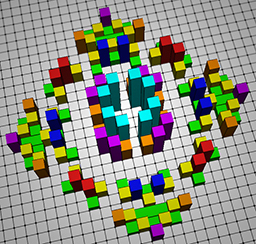And again, the game "Life"
 The theme of the game "Life" more than once rose to Habré . Various modifications of the game were described, I want to introduce one more. Modification of the game is quite trivial, but gives more opportunity for observation than the original.
The theme of the game "Life" more than once rose to Habré . Various modifications of the game were described, I want to introduce one more. Modification of the game is quite trivial, but gives more opportunity for observation than the original. In the classical rules invented by John Conway , each cell of the playing field can be in only two states: either the cell is empty or is filled with a chip.
Similar to evolution in nature, where the development went from unicellular to multicellular, it is logical to imagine the development of the Life game, where there can be more than one chip in a cell.
Thus, it is possible to represent the playing field in the form of a two-dimensional array of positive integers.

So, in addition to the standard conditions for the origin of life and its death, we will have the conditions of "growth" and "degradation":
- an empty cell, or a cell with a value of 0, gets a value of 1, provided that it is surrounded by 3 cells with a value greater than 0;
- a cell with a value greater than 0 will “grow”, that is, it will receive +1, provided that it has 2-3 neighbors with a value greater than 0;
- a cell with a value greater than 0 will take on a value of 0 if it has 1, 4-5 neighbors with a value above 0;
- a cell with a value above 0 will “degrade”, that is, its value will decrease by 1 (-1), provided that all neighboring cells have 0, or 6-8 neighbors have a value greater than 0.
In addition, it makes sense to determine the cell growth limit. It’s also a condition that determines what happens to the cell when it reaches its maximum.
Interpretation of the rules in the application settings:

These rules, of course, can vary and get results.
As we see, the behavior of cells with the new rules has become even more complex and interesting for observations.
Implementing Web
Mirror Web
Application for Windows
